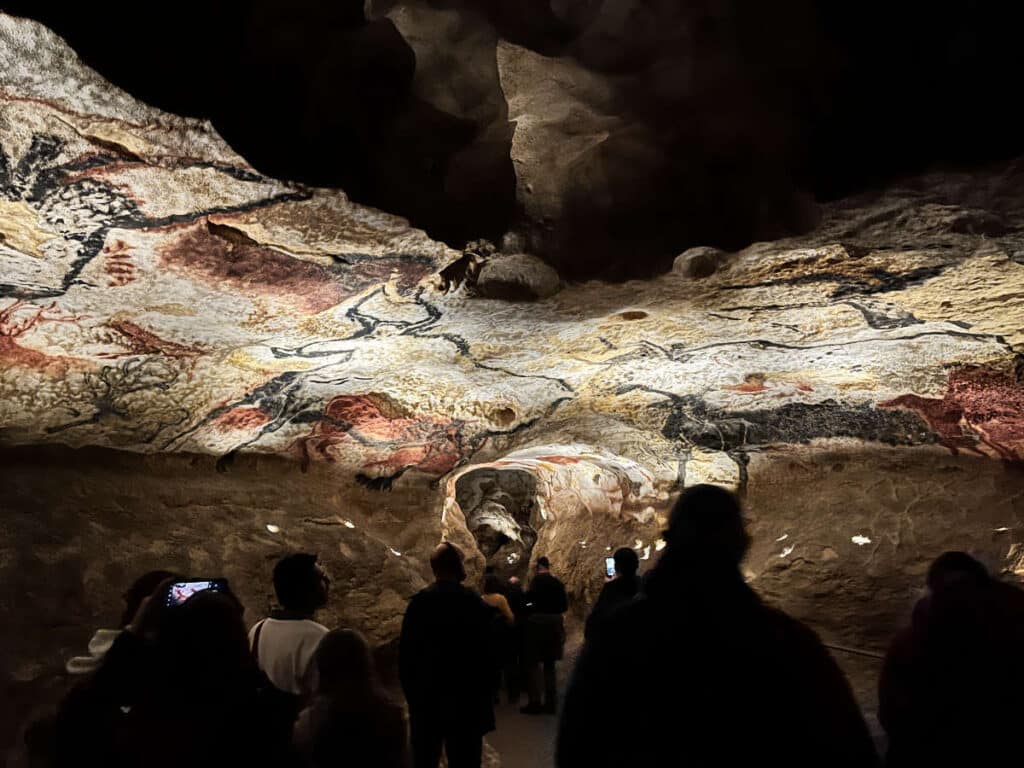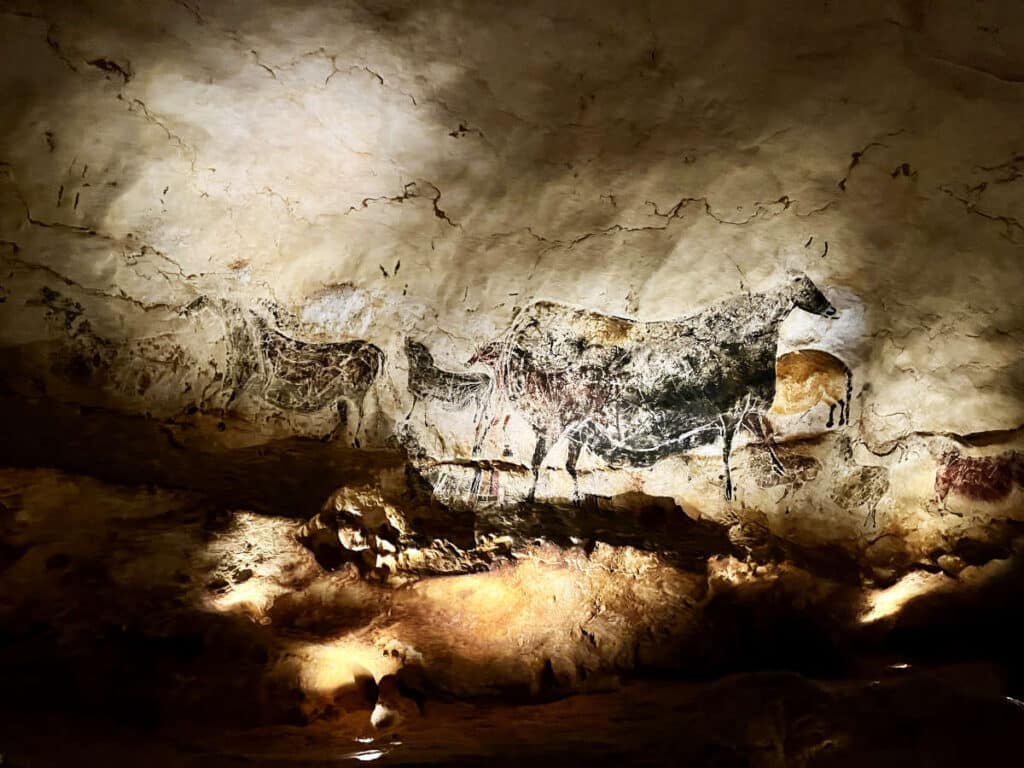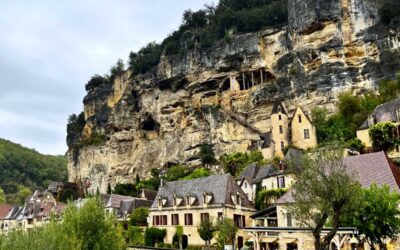Nestled in the picturesque French countryside, the Lascaux caves lie silent like a time capsule. Near the quaint village of Montignac in the heart of the Périgord Noir, it is here in 1940 that 4 teenagers and their dog stumbled upon an entrance to one of the most incredible caves in France.
They didn’t realize that they were unlocking a treasure trove of mesmerizingly clear art dating back between 17-000 to 20,000 years. Since then Lascaux has become famous for its ancient cave paintings linking us to prehistoric man.

News of the boys’ discovery quickly spread, and archaeologists and art historians descended upon the site to document and study the UNESCO heritage site.
In fact so many people wanted to visit, Lascaux IV, a replica of the caves was built for tourists to visit. So let’s see why the Lascaux caves continue to fascinate, and what there is to see at Lascaux IV. Allons-y!
History
On September 12th 1940, an 18-year-old named Marcel Ravidat followed his dog Robot who had stumbled upon an uprooted tree and a large hole in the ground. They were walking in the forest for a bit of respite from the news coming out of Paris.
It was a time of great turmoil, with the start of World War II and Paris had already fallen to the Reich. Despite this, Ravidad returned a few days later with his friends Jacques Marsal, Georges Agnel, and Simon Coencas. Armed with curiosity and makeshift lanterns, the boys entered the cavern.
Vibrant paintings adorned the cave walls, depicting a menagerie of animals such as horses, bison, aurochs, deer, and more. The paintings were a lively dance of ochre, black, and earthy tones all melding into each other.
Although they were not experts, they realized the importance of what they were seeing. They returned 9 days later with the local catholic priest (who also happened to be an archeologist) Abbé Henri Breuil on 21 September 1940.
As news of the discovery spread the Lascaux caves became a portal to the Upper Paleolithic era, offering a rare glimpse into the artistic prowess of our distant ancestors from 17-000 to 20,000 years ago.

The war raged on however. The 4 boys survived the war, as did Abbé Brueil, and continued their work. As word spread however, the Lascaux caves began to deteriorate.
The breath of so many tourists and scientists caused a fungus to grow onto the cave walls, destroying much of the paintings. Breuil would make many sketches of the cave, some of which are still used as study material today due to the extreme degradation of many of the paintings.
Today, visiting original Lascaux caves is restricted to scientists. The first meticulous replica of the Lascaux Caves, which is known as Lascaux II, was opened to the public in 1983. Subsequently a travelling exhibition known as Lascaux III tries to bring the prehistoric era to life.
When Grotte Chauvet (in nearby Ardeche) was discovered 55 years later in 1994, protective measures were taken immediately. From the start only a handful of scientists were allowed at Chauvet at a time.
The Grotte Chauvet cave paintings are older, atleast 28,000-32,000 years old, and even more fragile. In a way, they owe their preservation to the caves at Lascaux. (When another cave called Grotte Cosquer in Marseille was found in 1991, access was also immediately limited.)
Either way, it is the Lascaux caves that remain more famous, having captured the imagination of so many for so long.
The most recent is Lascaux IV, which is what is open to tourists today. This facsimile allows visitors to experience the magic of the cave art galleries while protecting the original site.
Inside the Lascaux caves
When you arrive at Lascaux IV, you will notice quite a modern building. Inside the first part of the visit includes the cave sequence where the artwork is reproduced through cutting-edge technology and faithful attention to detail.
The compositions on the cave walls are rather detailed, with the animals layered on top of each other. The depictions showcase a deep connection between early humans and the animals that they perhaps domesticated.
The cave art at Lascaux is celebrated for its exceptional quality and diversity. The artists are believed to have used natural pigments such as iron oxide, manganese dioxide, and charcoaL.

The older Grotte Chauvet cave paintings included carnivores like lions, while Lascaux is mainly farm animals.
The most famous panel at Lascaux, known as the Hall of the Bulls, features larger-than-life renditions of aurochs, horses, and deer. The Great Black Cow, with its majestic horns and powerful presence, stands out as an emblematic symbol of the ancient artist’s reverence for the natural world.
After a visit to the cave reproduction, you can head over to the interactive exhibit which has games for children and analysis of the paintings for visitors of all ages.

How to get to Lascaux?
The Lascaux caves are about 326 miles (525 km) from Paris and is about 125 miles (200 km) from Toulouse and Bordeaux. The only way to get to Lascaux is by car. If you don’t wish to drive, there are tours to Lascaux available from Bordeaux or nearby Sarlat-la-Canéda.
How long does a visit take?
There is the main cave visit, along with an interactive exhibition with games to play for young children. In all, it can take around 2-3 hours to go through the Lascaux caves exhibit, depending on how much time you want to spend inside.
When is the best time to visit?
The area around the Lascaux caves is very popular with French and European tourists in the summer for hiking, kayaking, and of course all the beautiful villages around. As such, the Lascaux caves do get very busy in the summer time, and it may be better to go during the off season.
When you do visit, be sure to leave enough time to visit the Gouffre de Padirac caves and historic pilgrimage village of Rocamadour as well, which are about 40 miles (65km) away.
Where should you stay?
There are some great hotels in neighboring Sarlat-la-Canéda from where you can explore the Lascaux caves and surrounding countryside:
- €€€ – Hôtel Montaigne
- €€€€ – Plaza Madeleine & Spa
- €€€€ – La Villa des Consuls
Sarlat makes a great base to visit the nearby villages of Domme, La Roque-Gageac, Castelnaud-la-Chapelle, Château des Milandes, Beynac-et-Cazenac and more.
The medieval Château de Castelnaud with its military animations, and the former castle of English King Richard the Lionheart Château de Beynac is just a 20 minute drive away. All these attractions are located within 20 miles of the Lascaux caves.

If you enjoyed that article, you may like to read more about traveling around Nouvelle Aquitaine. A bientôt!




